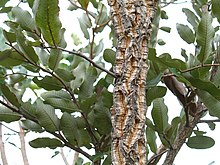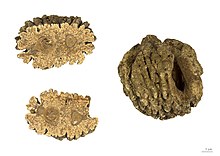| Parinari | |
|---|---|

| |
| Parinari curatellifolia | |
| Scientific classification | |
| Kingdom: | Plantae |
| Clade: | Tracheophytes |
| Clade: | Angiosperms |
| Clade: | Eudicots |
| Clade: | Rosids |
| Order: | Malpighiales |
| Family: | Chrysobalanaceae |
| Genus: | Parinari Aubl.[1] |
| Species | |
|
See text | |
| Synonyms | |
| |

Parinari is a genus of plant in the family Chrysobalanaceae.[2]
Species of genus Parinari are found in Subsaharan Africa from Senegal to Sudan and Kenya and south to Namibia and Natal; in Eastern Madagascar; from Indochina through Indonesia, New Guinea, northern Queensland, and the southwest Pacific; and in Central and South America from Costa Rica to Trinidad and southern Brazil.[1][2] The oldest fossils of Parinari fruits are from the early Miocene of Ethiopia, Panama, and Colombia.[2]
The genus is closely related to Neocarya.[3]
Parinari can be distinguished from other genera in Chrysobalanaceae by the following characteristics:[4]
- zygomorphic floral symmetry
- 6-10 unilaterally-attached stamens per flower
- ovary at side or mouth of receptacle-tube
- leaf lower surface lanate and with hair-filled stomatal cavities and parallel secondaries closely spaced
- pair of glands on leaf petiole
- large, woody fruits
Species[edit]
As of May 2014[update] The Plant List recognises 42 accepted species (including infraspecific names):[5]
- Parinari alvimii Prance
- Parinari anamensis Hance – Annamese burada
- Parinari argenteo-sericea Kosterm.
- Parinari brasiliensis (Schott) Hook.f.
- Parinari campestris Aubl.
- Parinari canarioides Kosterm.
- Parinari capensis Harv. – Dwarf mobola plum
- Parinari cardiophylla Ducke
- Parinari chocoensis Prance
- Parinari congensis Didr.
- Parinari congolana T.Durand & H.Durand
- Parinari costata (Korth.) Blume
- subsp. polyneura (Miq.) Prance
- subsp. rubiginosa (Ridl.) Prance
- Parinari curatellifolia Planch. ex Benth. – Mobola plum
- Parinari elmeri Merr.
- Parinari excelsa Sabine – Guinea plum
- Parinari gigantea Kosterm.
- Parinari hypochrysea Mildbr. ex Letouzey & F.White
- Parinari insularum A.Gray
- Parinari klugii Prance
- Parinari leontopitheci Prance
- Parinari littoralis Prance
- Parinari maguirei Prance
- Parinari metallica Kosterm.
- Parinari montana Aubl.
- Parinari nonda F.Muell. ex Benth. – Nonda plum
- Parinari oblongifolia Hook.f.
- Parinari obtusifolia Hook.f.
- Parinari occidentalis Prance
- Parinari pachyphylla Rusby
- Parinari panamensis Jud, Nelson & Herrera
- Parinari papuana C.T.White
- subsp. salomonensis (C.T.White) Prance
- Parinari parilis J.F.Macbr.
- Parinari parva Kosterm.
- Parinari parvifolia Sandwith
- Parinari prancei Kosterm.
- Parinari rigida Kosterm.
- Parinari rodolphii Huber
- Parinari romeroi Prance
- Parinari sprucei Hook.f.
- Parinari sumatrana (Jack) Benth.
References[edit]
- ^ a b "Parinari Aubl". World Checklist of Selected Plant Families. Royal Botanic Gardens, Kew. Retrieved 2014-05-18.
- ^ a b c "Jud, N.A., C. Nelson, F. Herrera, 2016 Fruits and wood of Parinari from the early Miocene of Panama and the fossil record of Chrysobalanaceae. American Journal of Botany 103 (2) 277-289.". Archived from the original on May 13, 2017.
- ^ Chave, Jérôme; Prance, Ghillean T.; Sothers, Cynthia A.; Dexter, Kyle G.; Chamagne, Juliette; Bardon, Léa (2013-01-01). "Origin and evolution of Chrysobalanaceae: insights into the evolution of plants in the Neotropics". Botanical Journal of the Linnean Society. 171 (1): 19–37. doi:10.1111/j.1095-8339.2012.01289.x. ISSN 0024-4074.
- ^ Prance, G.T.; Sothers, C. (2009). "Neotropical Chrysobalanaceae". In Milliken, W.; Klitgård, B.; Baracat, A. (eds.). Neotropikey - Interactive key and information resources for flowering plants of the Neotropics. Royal Botanic Gardens, Kew. Retrieved 2019-09-17.
- ^ "Parinari". The Plant List. Retrieved 2014-05-18.